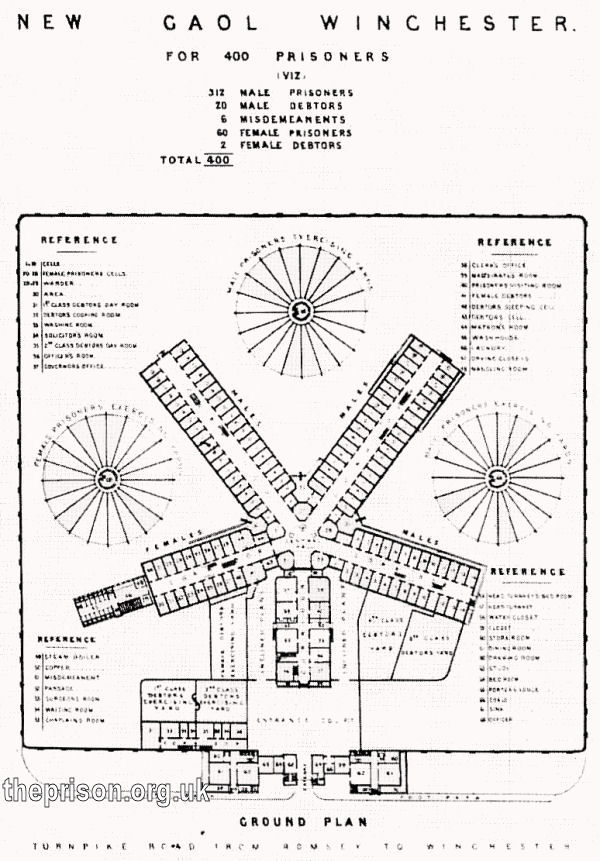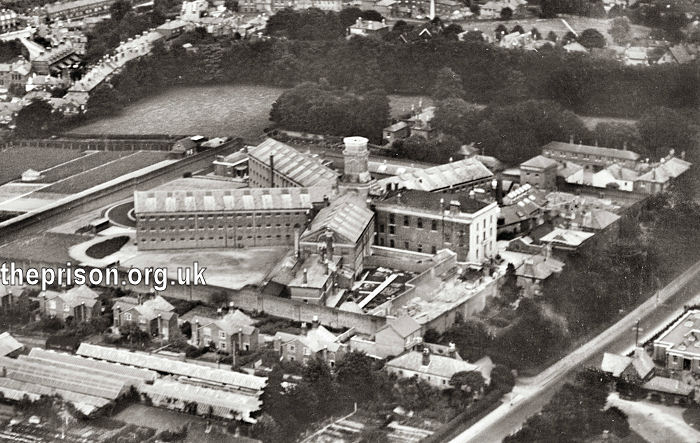County Gaol and House of Correction / HMP Winchester, Winchester, Hampshire
In 1849, a new, purpose-built County Gaol and House of Correction was opened on Romsey Road, in the West Hill area of Winchester. It replaced the existing County Gaol on Jewry Street and County Bridewell on King Alfred Place, and also included provision for housing debtors.
The new prison was designed by Charles James Peirce, who was also also the architect of Aylesbury County Gaol. His design was based on model plans devised by the government's Surveyor General of Prisons, Joshua Jebb. Its main building had with five wings radiating from a central supervisory hub and provided 400 separate cells.
Here is an description of the prison from 1859:
Hants County Prison, comprising the Debtors' and Felons' Gaols and a large House of Correction, is an extensive establishment, at West hil1, about 500 yards beyond the West gate and the County Hall; just within the city boundary, and adjoining the Head Quarters of the County Police. It was built in 1846-9, in lieu of the Old Gaol, in Jewry Sttreet, and the Old Bridewell, which stood on the site of Hyde Abbey. The Old Gaol was built in 1788, and enlarged in 1805, with an ornamental front, but ill-arranged interior. It had accommodations for l00, but was sometimes crowded with 120 or 130 prisoners. The Old Bridewell was erected in 1787 for about 50 prisoners, but it was considerably enlarged in 1820, and other years, till it had room for more than 200 inmates, These two prisons were in distant parts of the city, and were so inconveniently arranged that it was determined, in 1845, to take them down, and sell their sites and materials, except such portions of the Bridewell, as might be used in the erection of the present County Prison, which is one of the best in the kingdom, and has accommodations for about 450 prisoners. Its boundary walls enclose a square area of about six acres. The Governor's and Chaplain's Houses are on either side of the entrance gate. The Felons' Gaol and House of Correction form a large and massive pile in the centre, with five radiating wings, separating the different courts, and affording every facility for the inspection and classification of the prisoners. They contain 428 separate cells. The Debtor's Prison is a detached building, in the south-west corner of the enclosure, with accommodation for about 30 debtors; and on the eastern side of the yard is the corn mill, worked by the prisoners, many of whom are employed in pumping water, in making shoes, clothes, and mats; and in cultivating about three acres of garden ground. In addition to the internal accommodation for the officers, ten wardens' houses or cottages have been erected on the outside of the prison walls. The Chapel is in the central building, and is so fitted up that the prisoners cannot see each other. This extensive and well-conducted prison was opened in September, 1849, and cost upwards of £74,000, towards which about £12,000 was derived from the sale of the old prisons. On the east side of the prison wall is the County Police Office, or Head Quarters of the County Constabulary, which was built in 1847-8, at the cost of nearly £10,000, including the purchase of the land (£900), and the erection of a commodious house for the Chief Constable.

County Gaol and House of Correction Plan, Winchester, c.1849.
In 1859, the Inspectors of Prisons reported:
| Males. | Females. | Total. | |
| Prisoners received in the year | 1546 | 243 | 1789 |
| Daily average number | 242 | 34 | 276 |
| Greatest number at one time | 277 | 59 | 336 |
Average annual charge per prisoner-£21 3 7
This prison, which was first opened for the reception of prisoners in October 1849, receives, besides those especially belonging to the County, all prisoner's from the Boroughs of Andover and Winchester. The accommodation for male prisoners amounts to 315 cells, and for females to 59; these are exclusive of 17 reception cells for males, and 6 for females; as well as of 8 punishment cells for males, and 4 for females. All these are in connection with the ventilating and warming apparatus, and are of sufficient size, and furnished with all necessary appliances. The prisoners in confinement on the occasion of one of my inspections, on the 29th of June 1858, were as follow:—
| Males. | Females. | Total. | |
| Prisoners for trial at sessions | 33 | 2 | 35 |
| Prisoners for trial at assizes | 29 | 3 | 32 |
| Prisoners for examination | 1 | 0 | 1 |
| Convicted at assizes or sessions | 83 | 8 | 91 |
| Convicted under the Criminal Justice Act for Juvenile Offenders' Act | 23 | 8 | 31 |
| Convicted under the Naval or Military Laws | 31 | 0 | 31 |
| Convicted under the Revenue Laws | 1 | 0 | 1 |
| Otherwise summarily convicted | 36 | 20 | 46 |
| Debtors | 15 | 0 | 15 |
| ——— | ——— | ——— | |
| 252 | 31 | 283 | |
| ——— | ——— | ——— |
No complaints were made by any of the prisoners when separately questioned.
The employments of the prisoners on the same occasion, and the numbers occupied in each, were the following:—
| Males. | |
| At the crank-mill, pumping water, and grinding flour | 110 |
| At labour on the land | 6 |
| In mat-making | 4 |
| In shoemaking | 2 |
| In-tailoring | 4 |
| Cook's assistant | 1 |
| Baker's assistant | 1 |
| Cleaning the prison | 10 |
| Carpenter | 1 |
| Painter | 1 |
| Two were attending upon an epileptic prisoner; five were exempt from labour, by order of the Surgeon; and three were sick in their cells. | |
The hard-labour machines, of which unfortunately there are 100, are now never used, or so unfrequently as scarcely to be taken into account in the estimation of the prisoners' labour.
Of the women, 14 were engaged in the laundry, 6 in cleaning cells, 4 in needlework, the remainder being prisoners for trial and sick in the infirmary.
The accommodation for debtors of different denominations is as complete as the other parts of this excellent prison. The County Court debtors are placed in the basement, but the rooms are not more than half below the level of the ground.
It appeared to me that there was much risk of the escape of prisoners employed on the land outside of the prison, more especially as the superintending officer, in case a prisoner should run away, must be so long before he would be able to alarm the officers inside, and obtain assistance, that the runaway would have a great advantage. There is no fence whatever surrounding the land, but merely a wall of earth of no considerable height.
It is very desirable that some further means should be devised of employing the prisoners untried as well as convicted not working on the treadmill, for it will be perceived, from the statement given above of the employments of prisoners, that a considerable number were without any work at the time of my visit. The hard-labour crank machines have been very properly (as I think) laid aside as more calculated to retard than to promote the more enlightened objects of imprisonment; and even if they were still employed they would be inapplicable to the prisoners not sentenced to hard labour, who by law should be provided with labour not severe, and to the untried prisoners and debtors, who should have the option of employment.
It is stated that much improvement has taken place in the health and general aspect of the prisoners, from the adoption of open airing yards instead of the separate yards formerly in use. This observation is quite in accordance with the experience in other prisons in which a similar change has been effected. It is said that, the prisoners now leave the prison in a state of health fitting them for labour, and not pallid and bloodless as formerly.
The punishments indicted for breaches of prison rule are less numerous than, formerly, but a description of punishment has been in use for the last few years which seems to me scarcely warranted by law: namely, the depriving prisoners of their beds for one or two hours after the others have gone to rest. I apprehend that the Governor of a prisoner is not warranted in inflicting any prison punishment except that which is clearly defined in the 4lst section of the 4 Geo. 4. cap. 64., viz., the substitution of bread and water for his ordinary diet, and his confinement for a term not exceeding three days in solitude.
The situation of the infirmary is very inconvenient with reference to the airing yard. From the difficulty experienced by the patients in going up and down the stairs it has sometimes been necessary to keep them from taking exercise long after it would have been beneficial to them to do so. There has been no epidemic disease for a great length of time. Formerly diarrhoea was very prevalent, but for some years past there has been much improvement in this particular.

Winchester Prison, from the south-west.
Following the nationalisation of the prison system in 1878, the gaol became Her Majesty's Prison Winchester.
Today, Winchester is a Category B prison for adult males and for young offenders aged over 18.
Records
Note: many repositories impose a closure period of up to 100 years for records identifying individuals. Before travelling a long distance, always check that the records you want to consult will be available.
- Hampshire Record Office, Sussex Street, Winchester SO23 8TH.
- The National Archives, Kew, Richmond, Surrey, TW9 4DU. Has a wide variety of crime and prison records going back to the 1770s, including calendars of prisoners, prison registers and criminal registers.
- Find My Past has digitized many of the National Archives' prison records, including prisoner-of-war records, plus a variety of local records including Manchester, York and Plymouth. More information.
- Prison-related records on
Ancestry UK
include Prison Commission Records, 1770-1951
, and local records from London, Swansea, Gloucesterhire and West Yorkshire. More information.
- The Genealogist also has a number of National Archives' prison records. More information.
Census
Bibliography
- Higginbotham, Peter The Prison Cookbook: A History of the English Prison and its Food (2010, The History Press)
- Brodie, A. Behind Bars - The Hidden Architecture of England's Prisons (2000, English Heritage)
- Brodie, A., Croom, J. & Davies, J.O. English Prisons: An Architectural History (2002, English Heritage)
- Harding, C., Hines, B., Ireland, R., Rawlings, P. Imprisonment in England and Wales (1985, Croom Helm)
- McConville, Sean A History of English Prison Administration: Volume I 1750-1877 (1981, Routledge & Kegan Paul)
- Morris, N. and Rothman, D.G. (eds.) The Oxfod History of the Prison (1997, OUP)
- Pugh R.B. Imprisonment in Medieval England (1968, CUP)
Links
- Prison Oracle - resources those involved in present-day UK prisons.
- GOV.UK - UK Government's information on sentencing, probation and support for families.
Except where indicated, this page () © Peter Higginbotham. Contents may not be reproduced without permission.



